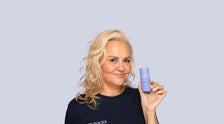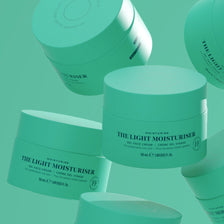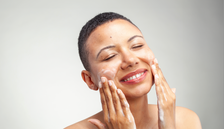Shop the full Skin Rocks Range
Hi Everyone!
A quick retinol Q&A to get us going in the vitamin A series. This is designed to help people new to vitamin A/considering starting to use retinol products. If you are old-school, hardcore, have been using a prescription strength of 1% for years, this advice won’t really apply to you. You may find the individual product reviews more helpful.
Some further points/clarification on the video:
Nothing featured in this entire series is an ad. No brand has paid to be included (nor was that an option). They were all chosen based on popularity/most-asked about in terms of reviews.
Vitamin A, when talked about in marketing terms – is generally referred to as ‘retinol’ in the way that vacuum cleaners are called ‘hoovers’ to a certain age demographic. 🙂
It’s also one of the most-searched for items on the blog so for ease, the video is called ‘Retinol Q&A’ but the series will cover products using different types of vitamin A and what brand names are listed on inci lists, such as retinyl palmitate, retinol, retinaldehyde, hydroxypinacolone retinoate (HPR), granactive retinol, adapalene (aka Differin), tretinoin (Retin-A), isotretinoin, and tazarotene. These are all names that you may have come across when reading about vitamin A, whether oral or topical, prescription or over the counter (OTC).
Firstly, let’s move isotretinoin capsules, otherwise known as Roaccutane to one side. This is the oral medication that is only available under the strictest usage instructions via prescription. If you are taking this you will have been made well aware of how to use/contraindications and complementary products for topical use alongside the drug.*
Retinoic acid is a brilliant cell-communicating ingredient that encourages your cells to behave like they did in their youth. Think of the varying derivatives as better signals on a mobile/cell phone. Retinyl palmitate is one bar in a foreign country – can be mildly effective but irritating, whilst at the other end of the scale, prescription strength Retin-A is BT Infinity Wi-Fi/5G. Works quickly, does not mess about, can still be irritating.
It is also used as an antioxidant that aids the prevention of free-radical damage in the first place.
You would generally consider using a retinoid to address the following issues:
Obvious wrinkles
Lack of tone and elasticity (jowls/saggy/baggy)
Uneven skin texture
May help shrink larger pores
Anti-acne benefits
How to use:
Apply at night (unless stipulated differently by a brand, which I will cover individually) on clean skin after cleansing.
You can use other products afterwards but leave a good gap to make sure your vitamin A has been given a chance to absorb. 20+ minutes is fine (unless stipulated otherwise).
Do not mix with acids (i.e. use at the same time of application). There was huge consensus on this across 99% of brands. Acids are exfoliators, as is vitamin A. Using them together runs the risk of 1: potentially reducing the effect of the vitamin A and 2: over-stimulating your skin. Retinoids, especially those at the stronger end of the scale, are designed to irritate, treat your skin kindly, don’t add another aggressor just because on paper ‘you can’. Use your skincare wisely, no-one wants to end up with stratus cosmeticus/contact dermatitis/a really sore face ‘just because you can’.
More of which to come during individual reviews/group overviews.
Use SPF. Every day. The end.
The current EU ‘recommended’ limit for pure retinol used in hand and face products is 0.3%.*
I will be talking about %s in the formulas, whether or not the brand made them available and how they are blended to give the effect of a higher %. Obviously, this will also highlight brands that are using/advertising %s above that guidance, and I will give those brands the chance to reply when covering them.
Retinol/Vitamin A as an ingredient is man-made, and vegan. Any brand calling their product ‘vegan’ should be referring to the entire formula and/or the lack of animal testing in their own product, but there is no need to say that there are no animal-derivatives in the actual vitamin A ingredient. I mean, it could happen, but it would be extremely unusual. Maybe if you’re buying from a source that is hard to oversee, like eBay. It’s akin to saying ‘there are no rabbits in this orange juice’. Why would there be? If, however, you are vegan/concerned with animal testing it’s worth noting that vitamin A, as a drug, will obviously have been tested on animals in the course of its lifespan as an ingredient. Individual OTC beauty products using a vitamin A ingredient are not subject to the same rules, and animal testing is obviously banned in the EU, and has been for some time. Again, whether or not the brand sells in territories where animal testing is required will be highlighted in review posts.
Hyaluronic acid – despite being called ‘acid’ – can vary in its PH depending on the formula, hence the potential to irritate an already-vulnerable skin that has been exposed to strong retinoids. I found gel consistencies like Hydraluron (again, not an ad) better than liquid variations and sprays. I can only tolerate the plainest of water mists when I’m using prescription strength retinoids.
The section discussing the usage of vitamin A products during pregnancy and breastfeeding is designed to put your mind at ease if you have been using such products and subsequently find out you are pregnant. However, if you are on prescription strength creams to treat acne for example, some derms will monitor you and allow you to keep using them. Some of them will also offer you salicylic peels in clinic, strengthening the case for less hysteria around topical OTC usage in pregnancy/breastfeeding. Your doctor knows you better than the internet does, including me.
*Sources/further reading:
Retinol levels:
https://ec.europa.eu/health/scientific_committees/consumer_safety/docs/sccs_o_199.pdf
Roaccutane usage information:
https://www.nhs.uk/medicines/isotretinoin-capsules/
Pregnancy and retinoid usage (this paper refers to prescription strength):
https://www.ncbi.nlm.nih.gov/pmc/articles/PMC3114665/
*Some of the information in this video may supersede previous advice given in the life of the blog – nearly 9 years. Where possible, I have updated those posts. Feel free to ask any Qs in the comments. Thanks!
My jumper is from ME + EM (gifted): http://bit.ly/2Sn4hSc
Hair is by Josh Wood (gifted): https://joshwoodcolour.com/pages/salon
Links promised:
Dr Kathleen Suozzi – she’s so lovely!: https://medicine.yale.edu/dermatology/people/kathleen_suozzi.profile
And a nice podcast I found with Dr Suozzi about work/life balance and how she got into oncology/dermatology – a great listen: https://youtu.be/kPJ7VD-3RBM
Questions asked via Instagram Stories:
When to start using?
How to use?
How to layer with other products?
Common Reactions?
I haven’t used it before, how do I start?
How to apply? What parts of the face?
Should everyone use it? I have FOMO.
Can we use it every evening?
How often should you increase the strength you are using?
Which products are equivalent? I.E. Luna vs Jordan Samuel
Best way to use without my face falling off? (quote) J
Supporting skin afterwards to prevent redness and soreness in the eye area?
Using acids?
Can you use retinol while pregnant or breastfeeding?
What would you use it for?
OTHER PLACES TO FIND ME:
Facebook: https://www.facebook.com/CarolineHironsOfficial/
Instagram: http://www.instagram.com/carolinehirons
Twitter: http://www.twitter.com/carolinehirons
Pinterest: http://gb.pinterest.com/carolinehirons/
This post is not sponsored. This post contains no affiliate links. I do not use affiliate links on products belonging to brands that I work with on a professional basis.
See my full disclaimer here: https://www.carolinehirons.com/page-about
The views expressed on this site are the author’s own and are provided for informational purposes only. The author makes no warranties about the suitability of any product or treatment referenced or reviewed here for any person other than herself and any reliance placed on these reviews or references by you is done so solely at your own risk. Nothing on this site shall be construed as providing dermatological, medical or other such advice and you are always advised to seek the advice of a suitable professional should you have any such concerns.




























